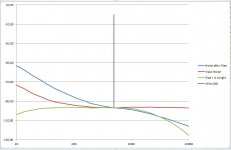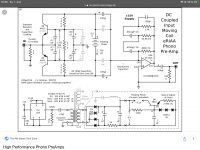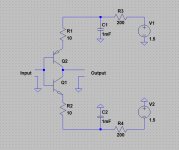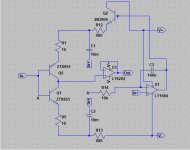But the effect of the '1G & capsule capacitance' noise is to make ambient stuff sound 'thick' so its still worth using 5G resistors & other stuff from Ye Olde Unobtainium Shoppe in a very low noise mike. 🙂
You would find all this stuff in my Linear Audio article. 5&10G SMT resistors are not too expensive and Ohmite makes 5G leaded resistors for those that can't deal with SMT (and keeping the boards clean). The FET is actually almost never the noise limit, the B&K tech papers are a goldmine for this stuff. In fact the lowest noise (for cheap) mic from Rode (5dBA) is all SMT and fairly ordinary FET.
Richard - thank you!
Scott - can you please check your email?
Sorry, luckily it was in a box near the top of my unpacked stuff I will post it tomorrow.
@Syn08: Expect a PM soon. Fortuitious occurance, can't say more or George will tell me off 😀
I've finally got approved on the mic builders account and digesting the stuff there. Couple of things for you Richard
1. You haven't mentioned if you think NPN and PNP should be matched in pairs or what parameters you personally have found critical other than noise. Any thoughts
2. You may have missed it, but between George and Hans they've managed to come up with some accurate models of MM generators for a subset of my collection which may be of academic interest.
Def building this once I have completed the (mumble*) other phono stages on the bench
*where mumble currently >3
I've finally got approved on the mic builders account and digesting the stuff there. Couple of things for you Richard
1. You haven't mentioned if you think NPN and PNP should be matched in pairs or what parameters you personally have found critical other than noise. Any thoughts
2. You may have missed it, but between George and Hans they've managed to come up with some accurate models of MM generators for a subset of my collection which may be of academic interest.
Def building this once I have completed the (mumble*) other phono stages on the bench
*where mumble currently >3
Put in a few more sims this evening and optimized the collector currents. The simple battery powered MC-HA is down at c. 200 pV/rt Hz using the Diodes Inc devices, and a similar design but using paralleled matched devices is at 173 pV/rt Hz. Will do a bit more work on some of the other designs and then update the compendium probably tomorrow. These circuits are at or below typical cart DC resistances - so I guess we are quickly entering diminishing returns territory now.
There is an ADI ultra low noise amp using an opamp and transistors (Brokaw?) - anyone have a link to a cct diagram/app note? I'd like to add that to the compendium.
There is an ADI ultra low noise amp using an opamp and transistors (Brokaw?) - anyone have a link to a cct diagram/app note? I'd like to add that to the compendium.
The reason I don't recommend the powered version is cos getting rid of PSU noise is a REAL PITA. It's MUCH easier for a DIYer (or indeed a true guru) to get SOTA noise with the battery version. The power version probably needs evil 1000uF caps. & other yucky stuff and the extra bits make the layout much larger & yuckier.
If I was doing a powered version again, I would look at doing it like this.
L C Audio Technology / RIAA/MC Amplifier
1000uF caps etc are really trying to float the PSU and the opto sources looks like a better way to do this. This implementation isn't the very best but better than most. If you want something off-the-shelf and single supply based, its definitely worth trying.
If you do buy one, please post on this thread. Us gurus & pseudo gurus will bug you for DC voltage measurements 😎
Have you tried that circuit you posted? Unless I'm missing something, I don't see how that could work. SFH206K has an open voltage of minimum 0.31V and average 0.365V (@1000lux). Three of these would add to 1V (remember, no load), unlikely enough to bias 2 x BE silicon junctions for any relevant collector current. Then the short circuit current of these is only 80uA. I could see it working with a few tens of uA collector current (far from any optimum for noise) with 4 cells in series, but with 3... unlikely.
http://www.farnell.com/datasheets/26602.pdf
so I guess we are quickly entering diminishing returns territory now.
My measurements of blank tracks on test LP's showed about 2.25nV per mV of cartridge sensitivity as the basic noise limit of the vinyl surface. This was factoring out all the confounding effects at low frequencies and simply looking at the high frequency noise which is white in spectrum.
My measurements of blank tracks on test LP's showed about 2.25nV per mV of cartridge sensitivity as the basic noise limit of the vinyl surface. This was factoring out all the confounding effects at low frequencies and simply looking at the high frequency noise which is white in spectrum.
Yes- agree we are well below the vinyl noise floor here. The JFET versions of which some have been built work very well even though they are 4-5 x noisier then the bip ones on paper. But, it’s all clean fun . . . 🙂
Hi,
wouldn't a small solar cell (say 5V, 40-80mA) be useable?
jauu
Calvin
You could rig up a LF ‘flying capacitor’ PSU.
The required supply voltage is so low, a few turns through the main PSU torroid would also be feasible.
Hi,
Instead of a 50/60Hz winding I'd rather prefer a isolated dc-dc converter with low interwinding capacitance.
Januar
Calvin
Instead of a 50/60Hz winding I'd rather prefer a isolated dc-dc converter with low interwinding capacitance.
Januar
Calvin
Scott,My measurements of blank tracks on test LP's showed about 2.25nV per mV of cartridge sensitivity as the basic noise limit of the vinyl surface. This was factoring out all the confounding effects at low frequencies and simply looking at the high frequency noise which is white in spectrum.
Should your 2.25nV per mV be read as 2.25nV/rtHz per mV@5cm/sec@1kHz ?
In that case S/N would be -70dB for a 20kHz BW, assuming that this noise would be flat from 20Hz to 20kHz.
However, this surface noise differs from record to record and can vary as much as 6dB.
Using the Adjust+ record, surface noise at 1Khz is -97dB below 1kHz@5cm/sec, resulting in -54dB S/N when also assuming a flat spectrum from 20Hz to 20Khz or the equivalent of 14nV per mV.
After Riaa S/N will improve, but even then 65dB seems to be the theoretical limit for the best LP record cutter.
See image below with the unprocessed Surface Noise in red, after Riaa in blue and and after Riaa + A-weight in green, all compared to the 0dB 1khz tone.
Did you possibly use a different way to achieve your data ?
Hans
Attachments
That's what I meant when I said "The redder-than-pink '1G & capsule capacitance' noise dominates most condensor mikes."You would find all this stuff in my Linear Audio article. .... The FET is actually almost never the noise limit, the B&K tech papers are a goldmine for this stuff. In fact the lowest noise (for cheap) mic from Rode (5dBA) is all SMT and fairly ordinary FET.
My 2c is that you should LISTEN to the noise as well as measure it .. certainly for any noise performance below 20dBA spl. Clavichord in a quiet room/studio and nature recording probably make the most demands on noise performance. In both these cases, you will clearly HEAR FET/acoustic resistance/preamp HISS even though this will be a small part of the overall noise. I think it was Eric Benjamin who suggested that perhaps electronic noise should simply be specified in an octave around 3kHz.
The MicBuilders exercise was with a mike very similar to Rode NT1 with its Schoeps circuit. You can clearly hear the advantage of removing the drain resistor. (Source resistor is in parallel with gm of the FET). Admittedly, all the cases were 10dB spl or less so moot for most users
And I'm not dissing the use of zillion G resistors in HiZ mikes. Much easier to get than in 1980 when most didn't obey Ohm's Law and behaved more like crappy diodes. In fact the MicBuilders exercise also shows the advantage of 5G over 1G.
Much easier to do spectrum plots today too. So once you hear something you object to, you can track it down. But you should always listen first so the measurements don't prejudice you.🙂
Hi,
Instead of a 50/60Hz winding I'd rather prefer a isolated dc-dc converter with low interwinding capacitance.
Januar
Calvin
Probably only a few pF given the 1.5 volt requirement and no HF hash around a front end gain stage (MC + MM) approaching 60 or 70 dB.
No matching is required especially for the battery version where the same current flows through each.1. You haven't mentioned if you think NPN and PNP should be matched in pairs or what parameters you personally have found critical other than noise.
In theory, some Vbe matching might be required for the powered version but I wouldn't bother myself. The current is determined by resistors. 1% resistors are OK as long as they are hand carved from solid Unobtainium by virgins. 🙂
The critical parameter is the specified transistors. I go on about LISTENING to your electrolytic capacitors but that won't affect the measured performance.
I'm quite serious when I suggest you knock up the battery version now and spend the next 30 yrs trying to equal its performance with a powered version. 😱Def building this once I have completed the (mumble*) other phono stages on the bench
That sounds about right. My measured 280pV/rt(Hz) was with a resistor pretending to be a cartridge.🙂The simple battery powered MC-HA is down at c. 200 pV/rt Hz using the Diodes Inc devices.
Need to remind everyone that the Common Base circuits have a best NF of 3dB. ie when properly matched, the total noise is 3dB more than that of the source alone.a similar design but using paralleled matched devices is at 173 pV/rt Hz. ... These circuits are at or below typical cart DC resistances - so I guess we are quickly entering diminishing returns territory now.
Running more current than the matched case, to get lower Env will result in more total noise cos the noise current will have gone up.
Common Emitter stages have a wider range of source resistance for good performance but unless you use a virtual earth, your feedback resistors become dominant. Resistors are EVIL 😀
If I was doing a powered version again, I would look at doing it like this.
L C Audio Technology / RIAA/MC Amplifier
Thanks for this syn08.Have you tried that circuit you posted? Unless I'm missing something, I don't see how that could work. SFH206K has an open voltage of minimum 0.31V and average 0.365V (@1000lux). Three of these would add to 1V (remember, no load), unlikely enough to bias 2 x BE silicon junctions for any relevant collector current. Then the short circuit current of these is only 80uA. I could see it working with a few tens of uA collector current (far from any optimum for noise) with 4 cells in series, but with 3... unlikely.
http://www.farnell.com/datasheets/26602.pdf
No. I have never tried it. Don't forget I'm a real beach bum this Millenium.🙂
When I first saw this a few years ago, the only SFH206 data(?)sheet I could find didn't even state voltage & current 😱
I assumed that as it was a commercial design, it would work. I should have been wary as there are no specs at all.
But the thing to do is to try it out and compare it with the battery version. Perhaps a little solar cell? Anyone game to have a go?
I'm quite serious when I suggest you knock up the battery version now and spend the next 30 yrs trying to equal its performance with a powered version. 😱
Moving forwards all my phono stuff will either be battery (using Jan's silent swticher) or phantom powered. Mainly cos I can...
Very nice to have all these variations together in one document.
What still seems to be missing is the ultra simple MC HA from John Curl.
It had 4 parallel PNP's and NPN's, supplied from two 1.5V batteries.
With modern ZTX transistors only one complementary pair will result in the same performance, see first image below.
To lower output impedance and distortion quite a bit, a low noise LT6202 can be added.
And finally to almost eliminate current flowing into the Cart, a LT1884 will do a perfect job, the whole circuit still being fed with with three 1.5 volt batteries supplying just 4 mA,
one battery for the negative and two for the positive supply, see second image.
The third image shows a fully differential topology, fed from a phantom power.
The circuit diagram at the right is shown as an OPA in the left part of the image.
Noise RTI after Riaa and A-weight is 48nV, or 0.34nV/rthz equivalent input noise.
Hans
Attachments
- Home
- Source & Line
- Analogue Source
- Richard Lee's Ultra low Noise MC Head Amp




